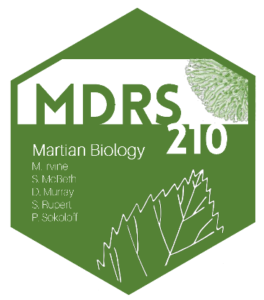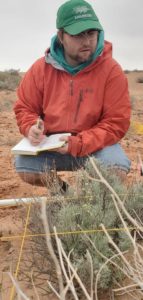 Mission Summary Report
Mission Summary Report
Mars Desert Research Station Crew 210
Martian Biology
Crewmembers: Dr. Shannon Rupert, David Murray, Paul Sokoloff, Samantha McBeth, Mike Irvine
Mission Overview
Crew 210 was an international team made up of scientists and outreach professionals from the United States and Canada, who conducted an assessment of the ecology and botanical diversity of the MDRS Exploration Area from April 13-20, 2019. This was the first non-simulation mission in a planned multi-year biological research program planned for the station; our overarching goal is to increase the ecological and biological knowledge about this unique Martian analog, and bring it up to the level of geological and planetary science research conducted by previous missions. The three planned peer-reviewed publications stemming from this year’s research program will provide useful data to future crews focused on astrobiology, as well as important scientific data for local scientific and government agencies. We also sought to increase awareness of MDRS and its mission through a robust online outreach campaign, including images, social media posts, video content, and interactive livestreams.
 Scientific Program
Scientific Program
Ecological Classification of the Exploration Area
To assess the different ecosystems within the station area, our team conducted vegetation transect and quadrat surveys at four locations (Copernicus Valley, Hab Ridge, and two sites along Cactus Road). At each location we plotted three 10-meter transects and surveyed five 1-meter-square quadrats along each transect in a zig-zag pattern.
For each transect we recorded GPS coordinates at the start and end, the air and soil temperature at the center of the transect, measured the height of the tallest plant on the line, and took a central sample for soil moisture, pH, and salinity. Within each of the five quadrats, we estimated percent cover of vascular plants, and named the top three species (by abundance) inside the square-meter.
By analysing the physical characteristics of the soil samples taken from our transects, we hope to discover the factors driving plant diversity (or the lack thereof) in the quadrats, and by extension, the different ecological areas around MDRS.
 Plant Sampling
Plant Sampling
Continuing work started by crew 143 in 2014, our team sampled new vascular plant and lichen specimens within the MDRS Exploration Area to better continue building a floristic baseline for the station. By pressing plant specimens between cardboard and drying them out, the team is left with a flat plant that, of stored correctly, will last for hundreds of years. The 64 new plant samples collected during this mission, accompanied by a label indicating the location and date of collection, will serve as the proof that these plants were found growing at a specific place and time. Once identified to species, these plants will make up the backbone of our first planned publication from this program.
 Outreach Program
Outreach Program
Our outreach program took advantage of the extensive network of Live It (liveit.earth) to educate the public on our mission and MDRS.
During one week of outreach the MDRS210 and Live It reached:
- 150+ classrooms during 2 livestreamed presentations in the field, roughly 3,000 students from K-12 participated. These presentations were recorded and continue to climb in viewership.
- 36 posts on Twitter with 10,000+ impressions
- 30+ posts on Facebook with 1,000+ interactions
- 22% increase in likes on the MDRS Facebook page
A combination of photo, video, 360 photo/video capture and livestreams were used to create content that was shared over Facebook, Twitter, Instagram, Live It and Discover the Universe’s networks.
We conducted an “Ask A Martian Anything” on Reddit, where we responded to about 50 questions (over 400 interactions on the website).
Looking Ahead
Our immediate plans are to publish the ecological and plant data in peer-reviewed journals, and to continue our outreach efforts using photos and videos taken on this mission. We are currently putting together a plan for future biological survey missions at MDRS, branching out into new groups including reptiles, birds, mammals, mosses, and microbial life.


 Mission Summary Report
Mission Summary Report Scientific Program
Scientific Program  Plant Sampling
Plant Sampling Outreach Program
Outreach Program
You must be logged in to post a comment.